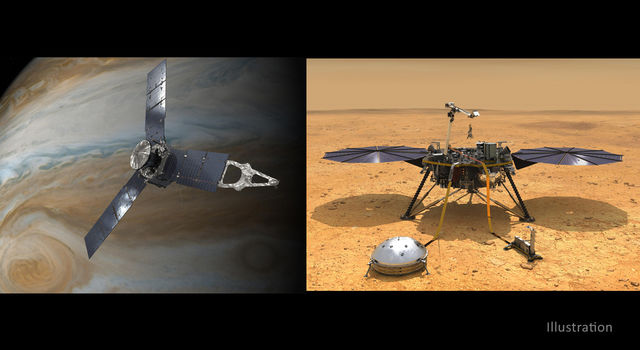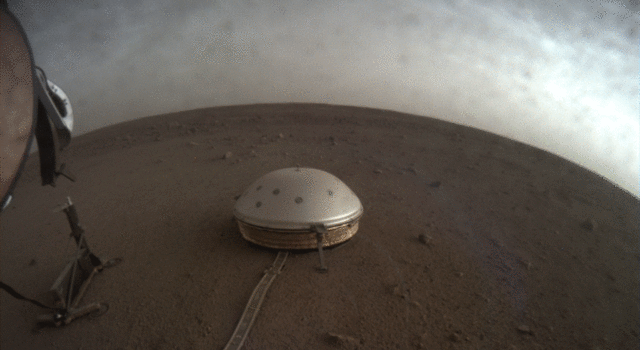Blogs | Dawn Journal | July 15, 2007
July 15, 2007
Dear Dawntothegrounds,
There are two ways for a spacecraft to leave its launch pad: climbing on a blazing tower of powerful flames accompanied by a thunderous announcement of its departure or suspended securely and gently on the crane that hoisted it there in the first place. Now Dawn has the opportunity to experience both, with the former to be in September and the latter this month. The spacecraft and third stage of the Delta rocket are being prepared now for removal from the second stage. They will be transported to the clean room at nearby Astrotech Space Operations before being returned to the launch pad in less than two months.
For more than a year, Dawn had been planning for a launch between June 20 and July 10. As is well known to readers of these logs in galaxies of all shapes, Dawn’s ion propulsion system affords it a flexibility in its trajectory unavailable to missions that use conventional propulsion. One of the important consequences of this is that, as we will see in more detail in the next log, the postponement of the launch to September does not change the scientific objectives or plans; even the dates for arriving at Vesta and Ceres are essentially unaffected. Dawn’s launch period was chosen based on the readiness of the project to begin the mission and on the schedule for the use of Cape Canaveral’s Space Launch Complex 17, from which Delta II rockets get their start to space.
In addition to Dawn lighting up the Florida skies, NASA has planned to launch an exciting Mars lander, Phoenix, this summer on a Delta II. Phoenix’s launch period starts August 3 and, like most planetary missions, without ion propulsion, if it were unable to launch within a few weeks, it would have to wait a very long time for the correct planetary alignment to recur.
There are two pads at the complex. Phoenix has been scheduled for pad A, and Dawn’s departure will be from pad B. The pads are less than 175 meters (575 feet) apart, and prudence dictates that a rocket not launch from one when a spacecraft -- an extremely precious resource -- is mounted on a rocket at the adjacent one. In addition, there are some shared facilities for the two pads, including the environmental control systems for the protective enclosures for the delicate hardware. (This also is why Dawn must be removed from 17B while Phoenix has its turn at the starting gate.)
These considerations led to the plan to end Dawn’s launch period early enough that there would then be sufficient time and resources to devote to preparing Phoenix for its launch.
Following a delay of 10 days in the production of Dawn’s rocket components earlier this year, the beginning of the launch period was rescheduled for June 30. The time required to repair a crane at 17B at the end of May and beginning of June pushed the earliest attempt to launch Dawn to July 7. There was much less flexibility in the closing of the launch period because of the need to preserve the schedule for Phoenix, but creative launch teams began looking into ways to launch Dawn a bit later than July 10.
Launching a mission into space requires much much more than the simultaneous cooperation of a rocket, a spacecraft, and the weather.
The Delta’s flight is fully controlled by its onboard computers. Even with this launcher’s extraordinarily high record of success, it is important for engineers to receive telemetry from the rocket during the major events of its short mission so they can verify that it performed correctly. This allows every launch not only to benefit from the successes of the previous ones but also, if necessary, to avoid those rare problems that do occasionally affect rockets. Each mission, with its unique trajectory, requires downrange tracking at certain locations. Antennas at many ground sites are available to track the vehicles, but often some portions of the flight are not within view of any of these stations. In such cases, ships or aircraft are used.
For the June 20 - July 10 launch, NASA had planned to use an aircraft (known as a P-3 Orion, a name sure to appeal to readers from Betelgeuse to Rigel) in the southeast Atlantic Ocean to receive data from the second and third stages. As the end of Dawn’s launch period changed, conflicts with prior commitments for that aircraft led to the decision to use a ship instead.
Tracking ships are leased by NASA from private owners and are outfitted with a system for acquiring the signals from the rocket. The principal burden this system carries is its name: ocean-going test and evaluation transportable resource (known to rocket scientists and lutrine dyslexics as OTTR, and pronounced “otter”). Standard telecommunications systems on the ships relay the data collected by the OTTR back to controllers via communications satellites.
After all preparations had been made for its voyage, including installing the OTTR hardware and vaccinating the crew members for yellow fever, the 57-meter (186-foot) vessel left its California port on June 6, as the Dawn operations team was conducting its ORTathon. The next day, the OTTR demonstrated that it was operating as expected by tracking a Delta II carrying an Italian spacecraft from Vandenberg Air Force Base in California to low Earth orbit. The ship was projected to be in position by July 4 to track Dawn’s launch on July 7.
On June 19, the OTTR’s transport reached the entrance to the Panama Canal. While awaiting its turn to transit the canal, the ship’s chief engineer conducted an inspection of the engine and discovered a problem in 1 of the 12 cylinders. The ship had been scheduled to stop in Puerto Rico, so arrangements were made to repair it there. Well before it left harbor at San Juan on June 29, it was apparent the OTTR would not reach its destination by July 7.
As soon as the OTTR’s transportation problems arose, NASA began working on alternate plans. As part of its normal set of equipment, a U. S. Air Force jet known as Big Crow (a modified KC-135, derived from the Boeing 707 design) has systems that could receive the Delta II telemetry. The plane was undergoing scheduled maintenance at that time in preparation for an appointment that would make it unavailable after July 9. Plans were formulated to have Big Crow track the launch should it occur on July 7, 8, or 9, with the expectation that the OTTR would be in position by about July 10.
Besides the time required to repair the engine, there were two other obstacles to the OTTR’s providing support for Dawn’s launch. Headwinds and rough seas prevented the ship from making progress at its expected speed. In addition, Dawn’s rocket would follow a different trajectory almost every day of the launch period, thus changing the required location for the ship to put the OTTR within view of the rocket’s flight. When the decision was made in May to switch from the Orion to the ship, some of the ascent trajectories were quickly replanned to ensure that the shift from one day to the next was within the ship’s daily travel range. But now the ship, already behind schedule, was fighting the uncooperative conditions of the Atlantic as it chased a target that moved each day.
Meanwhile, for a time, weather seemed to be a threat to Big Crow as well. It had to conduct a flight to verify all systems before it began the multisegment trip to Ascension Island, its base station for the daily flights to the coordinates for tracking Dawn’s launch. Bad weather delayed the check flight, but finally it was completed, and the bird flew to its temporary island roost in good time.
Weather certainly proved to be a hindrance at Cape Canaveral. Predictions of afternoon thunderstorms made Dawn’s July 7 launch appear unlikely, and prospects in subsequent days did not look much better. Formulating an accurate forecast of the weather conditions was essential. Two days before launch, the second stage of the Delta is loaded with its propellants. One of the two propellants is highly corrosive, and once the second stage has been exposed to it, the stage remains useful for only about 37 days. After that, this part of the Delta would have to undergo an extensive refurbishment or replacement, either of which would consume many months and be very expensive. There would not be enough time to have a restored or new second stage before late October, after which the changing alignment of the solar system would no longer allow even Dawn’s powerful ion propulsion system to accomplish the planned mission for many years.
With Dawn’s launch continuing to creep up on the opening of Phoenix’s launch period, it was essential not to load second stage propellants until favorable launch conditions were foreseen. Once the second stage was filled, poor weather, an unauthorized incursion of a boat or aircraft into the launch vehicle safety zone, a balky valve, a misbehaving sensor, or any of the other myriad glitches that can lead to a launch scrub could create a serious dilemma. If NASA made a subsequent attempt to launch Dawn, that would deprive Phoenix of some of its precious launch opportunities. If Phoenix were given priority so that it would have all of the planned chances to launch during its limited period, that would impose a very long and expensive delay on Dawn, after which its scientific goals would be compromised. Therefore, NASA was very diligent in waiting for all conditions to be satisfactory before fueling the second stage.
On July 7, after several days of postponements, with forecasts still showing a high probability of inclement weather at the time of Dawn’s daily launch windows, the projected date for the OTTR being in position continuing to slip, and the Big Crow needing to depart soon for its previously scheduled commitment, the decision became clear. The exploration of the solar system (and taxpayers who fund it) would be best served by not attempting to launch Dawn in July. Dawn has the capability to conduct its mission with a lift off after Phoenix, whereas the Mars lander needs to leave Earth in August.
This complex story would not have been told (even in this version, simplified so that readers of all species may reach the end in less than a generation) had myriad conditions not conspired to prevent the launch during the June - July period. There are too many aspects of reaching space and undertaking ambitious missions there to describe them all. Many are rarely mentioned because, complicated though they may be, they usually work well enough that they blend into the background. Of course, such a rich background is a crucial part of the tapestry we weave in attempting to probe the universe, and without it, the beautiful highlights would not be possible.
Now Dawn is preparing to vacate Space Launch Complex 17 while Phoenix prepares for the opening of its 3-week launch period on August 3. After Phoenix has left Florida for the chillier north pole of Mars, Dawn will once again take its place of honor at the top of the rocket. In the next log, we will see how Dawn gets to spend its unplanned Florida vacation as well as how the change in its launch date affects its mission of exploration far from Earth.
Dr. Marc D. Rayman
July 15, 2007
TAGS:DAWN, VESTA, CERES, DWARF PLANET, MISSION, SPACECRAFT







